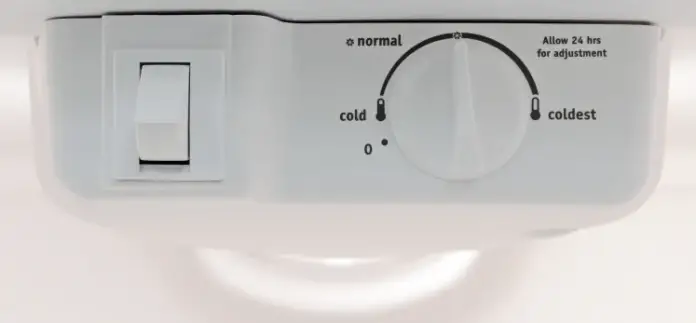
You’re standing at your fridge, knowing it needs to be colder, but not entirely sure how the dial works. You probably see numbers, but it doesn’t say the direction you should turn the refrigerator temperature control dial. Some do, but you aren’t so lucky.
Now you’re wondering which is the coldest. Turning it any which way is out of the question. Let’s clear up the confusion.
Which Number is the Coldest?
Now that you’re staring at your fridge temperature dial, which way do you turn it? Well, chances are you’re staring at a dial that has numbers, typically labeled 1 to 5, 1-7 or 1 to 9. To lower the temperature of the fridge, turn the dial higher up on the number line; 9 being the coldest, and 1 being the warmest.
That’s confusing for sure, because you’d think that the lower the number, the colder it gets, but that isn’t the case. Of course, that also asks another question: what’s the best temperature setting?
Depending on your model, you might have it easy and the label says “Cold” to “Coldest.” And if that’s the case, then it’s pretty straightforward which way you turn it to lower the temperature.
What’s the Best Temperature Setting?
Your first thought is that the colder your fridge is, the better your food is kept safe. That’s not entirely wrong, but your fridge does not have to be as cold as your freezer.
If you do, drinks would turn to ice and that’s not going to be fun. The fridge should be at or below 40 degrees Fahrenheit, preferably around 34 degrees Fahrenheit. That will keep drinks in liquid form without freezing anything.
Where is that on the dial? Right in the middle. It’s that simple! Keep the dial resting in the middle and your fridge will be nice and cool. Any further than that and you can run into ice buildup in your fridge and freezer or worse, your food freezes.
Keeping the Temperature Maintained
With that said, setting your fridge to the right temperature isn’t the whole picture. Sure, it might be on the right number, but if your fridge isn’t maintaining the right environment, it isn’t going to matter. That means keeping your fridge organized.
1. Don’t Open Your Fridge Door All the Time
It’s a bad habit to open your fridge and stand there, scanning the shelves for something to eat. Every product in your fridge experiences a flash thaw, which isn’t good for the lifespan of your food. It’s better that you first decide beforehand, then open the door and quickly grab everything.
That can be a pain, for sure, but you don’t have to memorize everything in your fridge. Instead, keep a list of everything that’s inside. This will help you plan ahead and reduce the exposure food has to higher temperatures.
2. Keep Your Fridge Clean and Tidy
Overstuffing your fridge can be a recipe for disaster. It reduces the flow of cool air from the vents, which then goes on to create pockets of cool air and others where it’s much warmer. How you order your fridge can help maintain an adequate temperature throughout.
Start by moving food and drinks away from the vents. Air needs to flow freely from those vents, and large, bulky products reduce its effectiveness. Furthermore, spread out the food in your fridge. If one product is hotter, it can transfer its heat to other food that’s right next to it.
Lastly, products like eggs should be placed lower on the shelf. It’s slightly cooler at the bottom than it is at the top. Hot air rises, after all.
